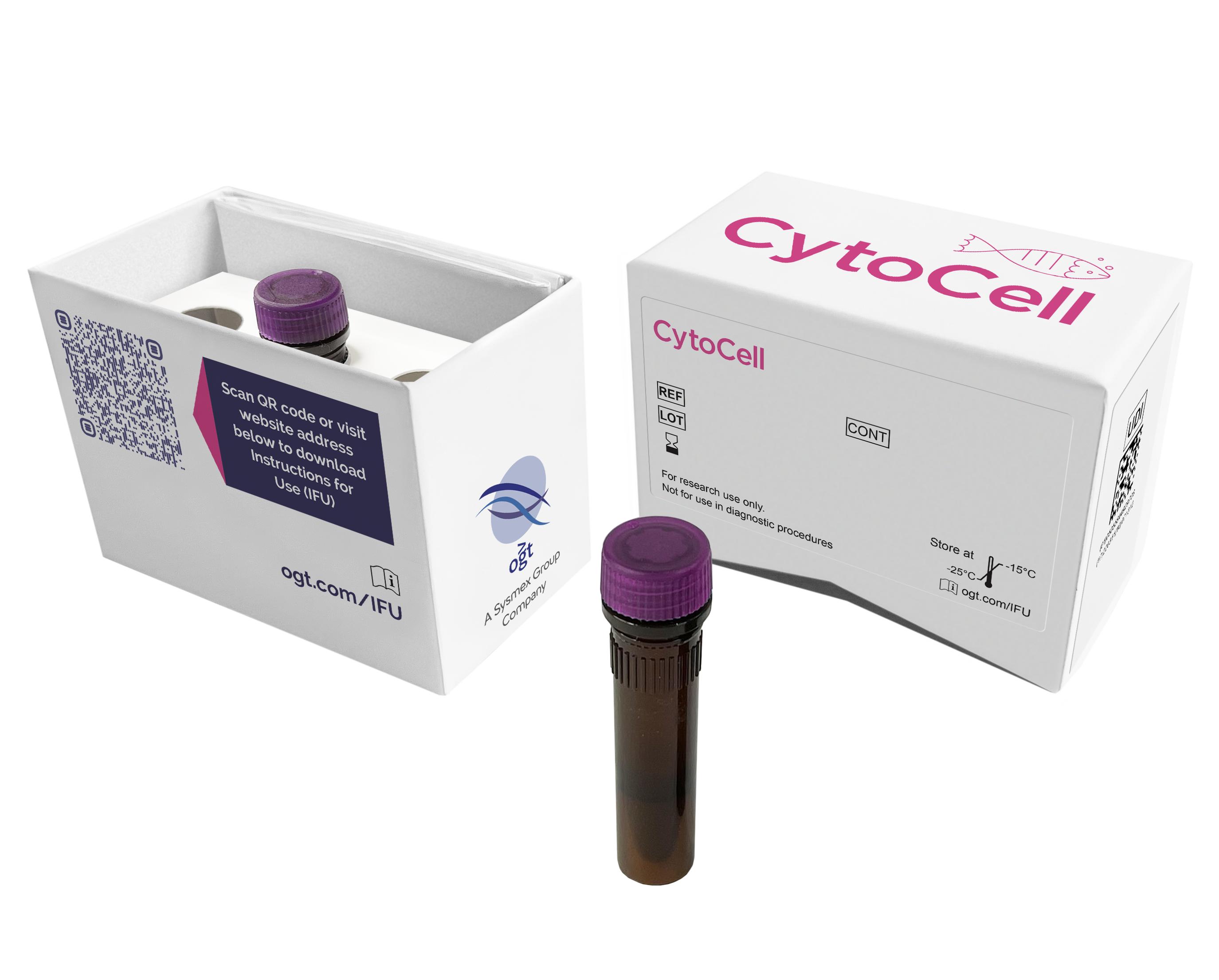
The KAL1 probe is 334kb, labelled in red and covers the entire KAL1 gene and the DXS278 and DXS7053 markers. The STS probe is 282kb, labelled in green and covers the STS gene and most of the HDHD1A and STS genes. The probe mix also contains a control probe for the X centromere (DXZ1), labelled in green.
Kallmann syndrome (KS) is a developmental disease characterised by olfactory deficiency3 and hypogonadotrophic hypogonadism (HH), which is responsible for the absence of spontaneous puberty1.
Kallmann syndrome is a heterogeneous developmental genetic disorder affecting approximately 1 in 8,000 males and 1 in 40,000 females2. Reports indicate three modes of inheritance: X-linked, autosomal dominant and autosomal recessive1,4.
It has been shown that mutations in the KAL1 gene on Xp22.3 result in the X-linked form of KS5. KAL1 consists of 14 exons and extends over 200kb and abnormalities of KAL1 reported in patients with KS include missense and nonsense mutations, splice site mutations, intragenic deletions and submicroscopic chromosomal deletions involving the entire KAL1 gene7.
Steroid Sulphatase Deficiency (STS) (also known as X-linked Ichthyosis)8 is the second most common type of ichthyosis and one of the most frequent human enzyme deficiency disorders.
Deficiency of the STS enzyme is known to be responsible for dark, adhesive and regular scaling of the skin9. The gene encoding this protein maps to the distal short arm of chromosome X, which escapes X-chromosome inactivation and has the highest ratio of chromosomal deletions among all genetic disorders10. Complete deletions of the STS gene have been found in more than 90% of patients11. The deletions can extend to involve neighbouring genes, causing contiguous gene defects. Therefore, STS may be associated with KS12.
In vitro diagnostic (IVD)
→ English/Français/Italiano/Deutsch/Español
→ Polski
Research use only (RUO)
Find certificate of analysis documentation for our CytoCell FISH probes
Our lab has been using a wide range of CytoCell FISH probes for a number of years, and have been increasing this range all the time. The probes have clear bright signals and show good reproducibility. CytoCell provides fast delivery of catalogue probes, and are very responsive when we have any queries or problems with their products.

Bridget Manasse
Addenbrookes Hospital, Cambridge University Hosiptals NHS Foundation Trust, UK
In our hands, CytoCell FISH probes have proven to be of the highest quality with bright, easy to interpret signals, thus providing confidence in our results. OGT's customer support is outstanding, as their staff are extremely knowledgeable and truly care about their customers and their customers’ needs.

Jennie Thurston
Director of Cytogenetics, Carolinas Pathology Group, USA
I first came across CytoCell FISH probes in a previous lab I worked in and I was struck by the quality of the products. Since this time, I have been recommending and introducing CytoCell probes across all application areas — now they are the primary FISH probes used in our lab. They have an excellent range of products and their ready-to-use reagent format saves considerable time.

Elizabeth Benner
Medical Technologist, University of Arizona Health Network, USA
We have been working with CytoCell fish probes for two decades because of their excellent clarity and intensity regardless of the size of the probe. It is so clear and simple to detect.
Dr. Marina Djurisic
Head of Laboratory of Medical Genetics, Mother and Child Health Care Institute of Serbia “Dr Vukan Cupic”, Serbia
The quality and consistency of CytoCell’s probes means I can trust the results, and my clients get their results in a timely manner.

Dr. Theresa C. Brown
Director, Cytogenetics Laboratory, Hayward Genetics Center, Tulane University School of Medicine, USA
It was very important for us to have more consistent results with our probes — easy-to-read bright signals and a range of vial sizes, which is much more cost-effective.

Janet Cowan, PhD
Director of the Cytogenetics Laboratory, Tufts Medical Center, USA
Not only do CytoCell offer an extensive range of high-quality FISH probes, the customer support is also excellent — providing fast access to all the probes I need. The probes are highly consistent with bright signals allowing easy scoring of results.
Dr. Eric Crawford
Senior Director, Genetics Associates Inc., USA
The quality and reproducibility of results using the CytoCell kit has been vital in accurately detecting co-deletions in our glioma investigations. We now have a cost-effective test that we can rely on that is also easy to use and interpret. We've been consistently impressed with this kit - not to mention the support offered by OGT's customer service, and have completely transitioned over to CytoCell probes.
Gavin Cuthbert, FRCPath
Head of Cancer Cytogenetics, Northern Genetics Servce, Newcastle, UK